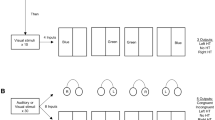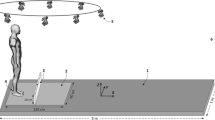Abstract
Research on attention and gait stability has suggested that the process of recovering gait stability requires attentional resources, but the effect of performing a secondary task on stability during obstacle avoidance is poorly understood. Using a dual-task paradigm, the present experiment investigated the extent to which young adults are able to respond to a secondary auditory Stroop task (requiring executive attentional network resources) concurrently with obstacle crossing during gait when compared with performing unobstructed walking or sitting (control task). Our results demonstrated that as the level of difficulty in the postural task increased, there was a significant reduction in verbal response time from congruent to incongruent conditions in the auditory Stroop task, but no differences in gait parameters, indicating that these postural tasks require attention, and that young adults use a strategy of modulating the auditory Stroop task performance while keeping stable gait performance under the dual-task situations. Our findings suggest the existence of a hierarchy of control within both postural task (obstacle avoidance requires the most information processing resources) and dual-task (with gait stability being a priority) conditions.


Similar content being viewed by others
References
Beauchet O, Dubost V, Herrmann FR, Kressig RW (2005) Stride-to-stride variability while backward counting among healthy young adults. J Neuroeng Rehabil 2:26
Brauer SG, Woollacott MH, Shumway-Cook A (2001) The interacting effects of cognitive demand and recovery of postural stability in balance-impaired elderly. J Gerontol Med Sci 56A:M489–M496
Brown LA, McKenzie NC, Doan JB (2005) Age-dependent differences in the attentional demands of obstacle negotiation. J Gerontol Med Sci 60A:M924–M927
Chen H-C, Aston-Miller JA, Alexander NB, Schultz AB (1994) Effects of age and available response time on ability to step over an obstacle. J Gerontol 49:M227–M233
Cohen G, Martin M (1975) Hemisphere differences in an auditory stroop test. Percept Psychophys 17:79–83
Ebersbach G, Dimitrijevic MR, Poewe W (1995) Influence of concurrent tasks on gait: a dual-task approach. Percept Mot Skills 81:107–113
Gage WH, Sleik RJ, Sleik RJ, Polych MA, McKenzie NC, Brown LA (2003) The allocation of attention during locomotion is altered by anxiety. Exp Brain Res 150:385–394
Hahn ME, Chou LS (2004) Age-related reduction in sagittal plane center of mass motion during obstacle crossing. J Biomech 37:837–844
Kahneman D (1973) Attention and effort. Prentice-Hall, Englewood Cliffs, NJ
Kahneman D, Chajczyk D (1983) Tests of the automaticity of reading: dilution of Stroop effects by color-irrelevant stimuli. J Exp Psychol Hum Percept Perform 9(4):497–509
Lajoie Y, Teasdale N, Bard C, Fleury M (1993) Attentional demands for static and dynamic equilibrium. Exp Brain Res 97:139–144
Lajoie Y, Teasdale N, Bard C, Fleury M (1996) Upright standing and gait: are there changes in attentional requirements related to normal aging? Exp Aging Res 22:185–198
Neumann O (1984) Automatic processing: a review of recent findings and a plea for an old theory. In: Prinz W, Sanders AF (eds) Cognition and motor processes. Springer, Berlin, pp 255–293
Posner MI (1994) Attention: the mechanisms of consciousness. Proc Natl Acad Sci USA 91:7398–7403
Shumway-Cook A, Woollacott M, Kerns KA, Baldwin M (1997) The effects of two types of cognitive tasks on postural stability in older adults with and without a history of falls. J Gerontol 52:M232–240
Siu KC, Woollacott MH (2007) Attentional demands of postural control: The ability to selectively allocate information-processing resources. Gait Posture 25:121–6
Sparrow WA, Bradshaw EJ, Lamoureux E, Tirosh O (2002) Ageing effects on the attention demands of walking. Hum Mov Sci 21(5, 6):961–972
Weerdesteyn V, Schillings AM, van Galen GP, Duysens J (2003) Distraction affects the performance of obstacle avoidance during walking. J Mot Behav 35(1):53–63
Wickens CD (1989) Attention and skilled performance. In: Holding DH (eds) Human skills. Wiley, New York, pp 71–105
Winter DA (1990) Biomechanics and motor control of human movement, 2nd edn. Wiley-Interscience, New York
Woltring HJ (1986) A FORTRAN package for generalized, cross-validatory spline smoothing and differentiation. Adv Eng Softw 8:104–113
Acknowledgments
This study was support by the National Institute of Health, Aging Grant # AG-021598 (M. Woollacott, PI).
Author information
Authors and Affiliations
Corresponding author
Rights and permissions
About this article
Cite this article
Siu, KC., Catena, R.D., Chou, LS. et al. Effects of a secondary task on obstacle avoidance in healthy young adults. Exp Brain Res 184, 115–120 (2008). https://doi.org/10.1007/s00221-007-1087-9
Received:
Accepted:
Published:
Issue Date:
DOI: https://doi.org/10.1007/s00221-007-1087-9




